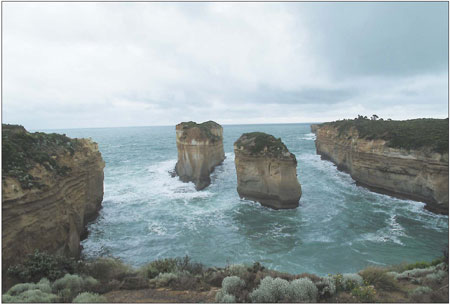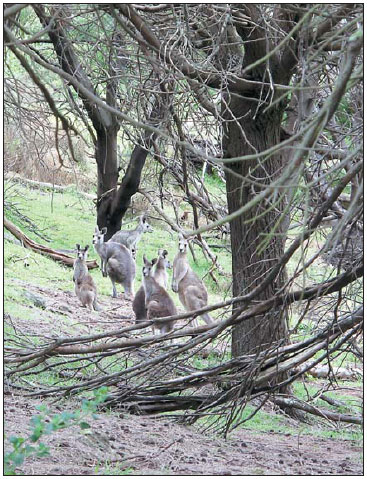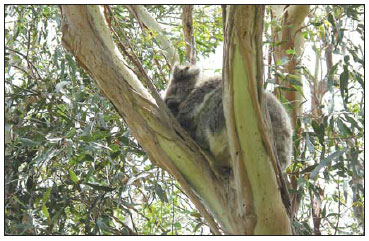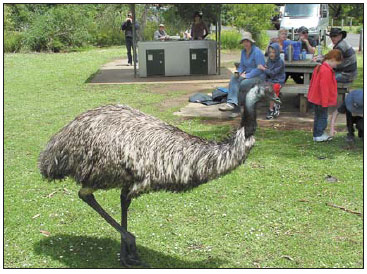| Chilled to perfection | |||||||||
http://english.dbw.cn
2011-03-01 11:13:18
|
|||||||||
|
A trip along the Great Ocean Road in Australia was colder than expected, but a feast for the eyes. Setting out for Melbourne in mid-December, from Beijing, I hesitated whether to take my down jacket as I thought it would be sunny Southern Hemisphere weather. I'm glad I did as it rained every day and strolling along Logans Beach in Warrnambool was a chilly experience because of the biting wind. I was told summer would only begin after Christmas in south Australia. As opposed to China, in Australia, the further south you go, the colder it gets. I was traveling with a group on the Great Ocean Road, a 243 km stretch along the southeastern coast of Australia that is reputed to have some of the most beautiful coastal scenery in the world. Logans Beach is a good site to spot Southern Right Whales in winter, when females and their calves stay close to shore, but now they were further to the south. Australia is a haven for wild animals. When we stopped at a picnic site to eat, emus came looking for something too. In the trees, koalas were sleeping - they do so for up to 20 hours in a day - but we also saw one koala walking on the road. We took a walk into the mountain behind the picnic site and a group of kangaroos watched us from a distance, some with joeys, or baby kangaroos. This was the first time I had seen kangaroos, though I saw their images everywhere in Australia - souvenir shops, bookstores, and even on the menu of a Chinese restaurant which serves "stewed kangaroo meat with Sichuan spices". Not sure how many people would enjoy that. Much of the Great Ocean Road is along cliffs composed of limestone and sandstone formed between 10 and 25 million years ago, when it was under the sea. The sea retreated and deep vertical joints formed in the rock. Rainwater and spray percolated down the joints, dissolving the rock and widening the cracks. The sea advanced again at the end of the last Ice Age, reaching its present level about 6,000 years ago. Since then, waves have been attacking and undermining the rock, thereby producing the cliffs. We enjoyed Bay of Islands, Bay of Martyrs, the Grotto and London Bridge, but the most famous site on Great Ocean Road is Twelve Apostles, a series of rocky stacks that have been abandoned to the ocean by the retreating headland. Walking along a timber boardwalk we arrived at the viewing platform for a panoramic view of the "apostles" and the Southern Sea. Here on the clifftop we could see a great distance into the sea, where waves came into being and ran towards the shore. Those who made it to the cliff were sculpting the next Apostle, which takes thousands of years to finish. Our group had deliberately arrived at sunset in order to avoid the crowds and we had the sights to ourselves. Dumbstruck by the spectacular view, we were immersed in cosmologic thoughts. It felt like the end of time and space. After dusk we headed to our hostel at the nearby town of Port Campbell. To cheer us up, our driver and guide, Bernie, began to sing Jingle Bells and made the bus swerve rhythmically. He then circled a traffic island three times before turning in the right direction. Screaming with laughter, we arrived at our hostel. The tour group I was in was designed for people like me who wanted to see more and spend less. The two-day, one-night trip promised one dinner and now it was time to enjoy it - a barbecue buffet. Bernie was our cook, but we all helped out. I chopped some carrots and made a salad with two other Chinese in the group, a young couple from Beijing on their honeymoon. There were also two travelers from Taiwan, three from Japan, and the rest of the 20-person group came from Europe. Some travelers had working holiday visas. A German girl said she worked in Australia at a car wash to save enough money to travel, and when she had spent the money she would find another short-term job. We stayed in simple dormitory rooms, each of which had six beds. Because of the traveling and jet lag, I went to sleep early, but some of my more energetic roommates went to a pub and returned late. Many companies organize day trips to the Great Ocean Road from Melbourne, but that means driving 600 km in a day and allows only a short stay at Twelve Apostles. The advantage of our tour was that we could relax and see the Twelve Apostles twice, the second time the next morning. This time I decided to do something different - a helicopter ride which would allow me to see the Apostles from above. An English woman traveler was my companion. We were told not to get too excited and jump around when walking under the propeller. Like a gentleman, I gave up the front seat to the English woman and sat at the back. Before the flight we tested our microphones and earphones through which we could communicate with the pilot. "Is this your first time in a helicopter?" asked the pilot. "Yes," we both answered. "Me too," the pilot said. He was joking, I hoped. The helicopter took off. We flew over the Apostles and watched them from the other side. In the daylight the scenery looked less desolate and brighter. The Twelve Apostles are not exactly 12 in number. There are more or less, depending on which ones you count. From the viewing platform I could clearly see seven, but now I saw more along the coastline. The pilot told us that this part of the coastline had seen a lot of ship wreckages, the most famous of which happened in 1878 when the iron-hulled dipper Loch Ard foundered on the final night of its long voyage from England. Of the 56 people onboard, only two survived, one of whom was a non-swimmer who clung to the wreckage and was washed into what is now called Loch Ard Gorge, just beside the Twelve Apostles. Before I had time to imagine how the survivors climbed up the cliff we had to return to base and land. But I felt I had experienced a lot in those eight minutes. |
|||||||||
| Author: Mu Qian Source: China Daily Editor: Wu Qiong |
|||||||||
 中文简体
中文简体














